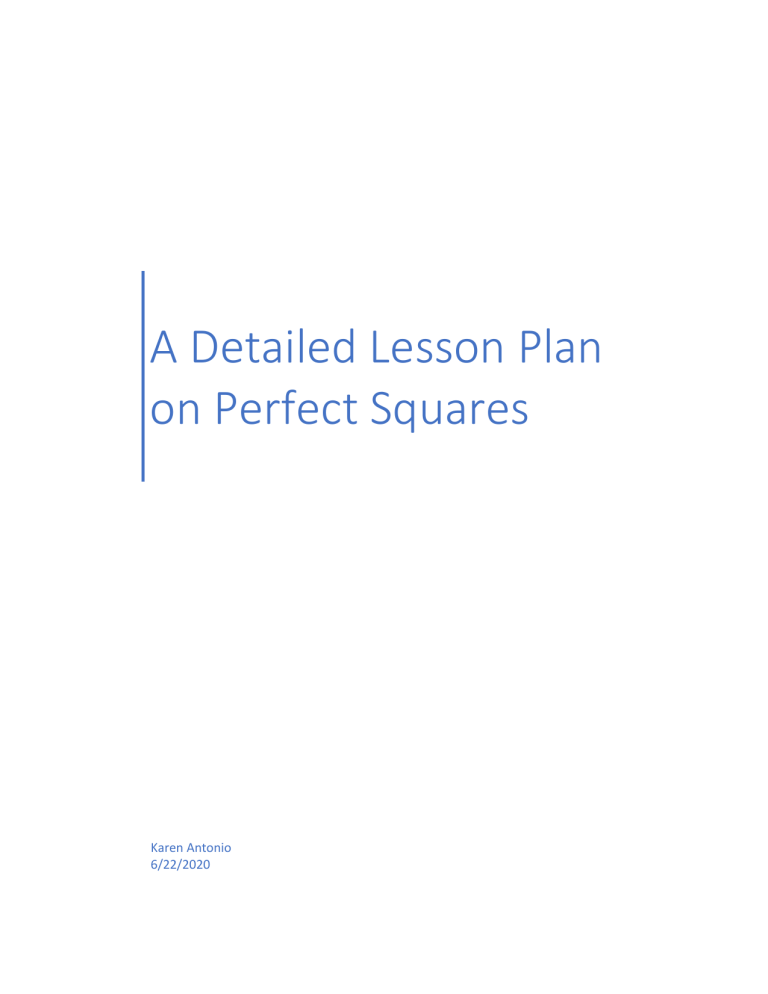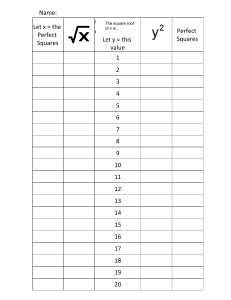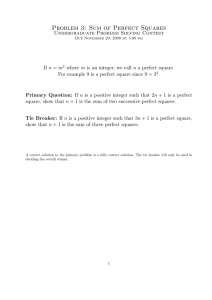
A Detailed Lesson Plan on Perfect Squares Karen Antonio 6/22/2020 I. Objectives a. Define a perfect square. b. Understand and identify perfect squares. c. Develop learners’ number sense II. Subject Matter Topic: Introduction on Perfect Squares Materials: PPT presentation, print-out puzzles Strategies: Interactive learning III. Procedure Teacher’s Activity 1. Preliminary Activities Learners’ Activity - A. Daily Routine - Prayer - Greetings - Checking of Attendance B. Review - Quiz about the last topic C. Motivation - What are the properties of a square? - A square is a quadrilateral whose interior angles and side lengths are all equal. - Is this a square? - How many units? - Now, try making a square with 2 tiles - Is it a square? What figure is that? - Now let’s try adding 2 more tiles and let’s see if it is possible to form a square - Rectangle with 4 equal sides Each interior angles of a square is 90° - Yes - Only 1 unit - It’s a Rectangle - Here’s your task I’ll give you 4 minutes to build as many different squares as you can on your grid papers. After 4 minutes check the learners’ papers 2. Lesson Proper A. Introduction - The activity we’ve done has something to do with our lesson for today and now I want you to read these questions and hopefully after this discussion you can answer them correctly. - Can you make a square from 5 tiles? Why or why not? Draw a picture or create a model to support your answer. - Why do you think that 1, 4, 9 and 16 are called perfect squares? - How can we determine if a number is a perfect square or not? B. Discussion - A perfect square by definition is a number that is the square of an integer - What is an integer again? - Good Job! - In other words, we could take an integer then square it and the resulting number is a perfect square. - - 𝒎 = 𝒏𝟐 You may not realize it, but you have already been exploring perfect squares. - An integer is a number that can be written without a fractional component. - The perfect squares can be found along the diagonal of the multiplication table when a whole number is multiplied by - N - i t s e l f 𝑚= 9 - There are infinite numbers of perfect squares but let’s take a look to a few to get an idea what they look like. - Let n be an integer; m be the perfect square - 𝒎 = 𝒏𝟐 Example #1 - n=1 𝟐 - 𝒎=𝟏 ? - Therefore, 1 is a perfect square - 𝒎=𝟏 - 𝒎 = 𝟗 and it’s a perfect square Example #2 - n =3 - 𝒎 = 𝟑𝟐 ? - Very Good! Example #3 - n=4 - Excellent! - Can someone draw the tiles now? - Amazing! 3. Application Matchy Matchy Direction: Match the puzzle pieces as fast as you can - 𝒎 = 𝟒𝟐 - 𝒎 = 16 4. Generalization - No, because it’s not a perfect square. - 1, 4, 9, and 16 are called perfect squares because they’re the square of an integer - By drawing tiles - By using this equation 𝒎 = 𝒏𝟐 Let’s wrap it up! IV. - Since you did a great job, I believe you can answer these questions easily - Can you make a square from 5 tiles? Why or why not? Draw a picture or create a model to support your answer. - Correct! - Why do you think that 1, 4, 9 and 16 are called perfect squares? - Correct! - How can we determine if a number is a perfect square or not? - Excellent! Evaluation I. Direction: Circle the number in each row that is NOT a perfect square: 3 25 81 100 121 4 12 9 144 36 1 16 27 49 64 II. Direction: Find the square of each number. 1. 3 2. 22 3. 25 4. 24 5. 35 6. 26 7. 37 V. Assignment 1. What is a square root? 2. What is a radical sign? 8. 50



